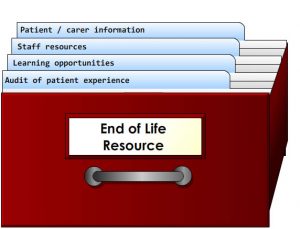The team designed a tick-box form to assess 5 sets of case notes. The table below shows the layout they used. Each of the 5 patients has a column. Tick the box in the column for each patient if you find documented evidence that the aspect of care mentioned beside the box has been completed. A higher score = good documentary evidence this aspect has been evidence has been addressed.
|
1 |
2 |
3 |
4 |
5 |
comments |
| Discussion of DNACPR status |
|
|
|
|
|
|
| Appropriate referral to specialist palliative care service |
|
|
|
|
|
|
| Advance care directive been considered |
|
|
|
|
|
|
| Record of preferred place of death |
|
|
|
|
|
|
| Indicators of poor prognosis assessed |
|
|
|
|
|
|
| Evidence of discussion with family |
|
|
|
|
|
|
| Explore organ & tissue donation wishes of patient |
|
|
|
|
|
|
| Use of symptom assessment tool (pain, agitation, respiratory tract secretions, nausea and vomiting, dyspnoea) |
|
|
|
|
|
|
| Regular assessment of symptoms |
|
|
|
|
|
|
| Anticipatory prescribing |
|
|
|
|
|
|
| Needs of carers assessed |
|
|
|
|
|
|
| Clear plan of care |
|
|
|
|
|
|
| Outcomes of MDT meetings |
|
|
|
|
|
|
| Addressing spiritual needs |
|
|
|
|
|
|
You could also use an end-of-life quality assessment tool such as: NICE Quality standards – end-of-life quality assessment tool.
The nurse’s task in Esther’s case is to review how the team assess and manage patients’ symptoms in end-of-life care. Due to the effects of stroke there may be particular challenges which the team should be aware of e.g. hemiplegia, aphasia and cognitive problems. These stroke specific complications can make it more challenging to assess and manage end-of-life symptoms. All care should be tailored to the individual and highlighted in their care plan.
For further information on symptom management in end-of-life care:
The consultant’s task is to consider how to provide prognostic information to families. Families are always keen to know the potential for future recovery and also need to know if there is a likelihood of imminent death. It is important that families are able to speak to the medical team soon after the stroke and have their questions answered as fully as is possible at the time.
- Predicting outcome in acute stroke can be difficult because the trajectory of recovery after an acute stroke is not always predictable, especially in patients with intracerebral haemorrhage
- In many patients full or partial functional recovery is realistically expected and full rehabilitation is appropriate
- For some patients the extent of irreversible damage is moderate or unclear and there is associated uncertainty as to the patient’s survival
- Where there is extensive brain damage ( and often also co-morbidities) and death in a matter of days is likely it is important families know this
The AHP Team Lead’s task is to consider whether Esther could have gone home. Statistics on the number of people dying at home vary by medical condition and currently the majority of deaths from acute stroke occur in hospital. It is useful to check what happens in your own health board area.
The AHP Lead understands that many people will express a preference to die at home, however after an acute event such as a stroke when family are faced with the reality, many may change their minds and want more extensive support.
In Esther’s case, not achieving a discharge home should not be viewed as a team failure. Esther’s deterioration was unpredictable and therefore the opportunity to plan was limited. However stroke services should be aware of the agreed aim to increase the number of people who die in the location of their choice as specified in the national strategies, such as the 2008 report Living and Dying Well: Living and dying well (PDF, 489KB), and the 2015 Strategic Framework for Action, to improve palliative and end of life care. Liaison with primary care teams is essential to ensure the appropriate nursing and supportive care package is in place. Dying at home is considered an indicator of ‘quality of death’ by Healthcare Improvement Scotland.
Esther’s wishes for preferred place of death had been verbally expressed to her family but she did not have a formal anticipatory care plan. What is an anticipatory care plan?
The junior doctor’s task is to review the national guidance on DNACPR decision making.
NHS Scotland has a DNACPR policy for integrated documentation and communication of the decision: Cardiopulmonary Resuscitation (CPR) Decisions [PDF]
Each member of the team is given a task to undertake before the next team meeting.



